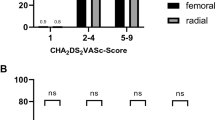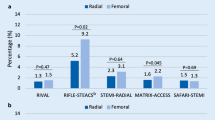Abstract
This study evaluated whether radial access intervention had a lower risk of post-treatment adverse events in acute coronary syndrome (ACS) even in Japan where the use of a strong antithrombotic regimen was not approved. We retrospectively analyzed a large nation-wide registry in Japan to compare the incidence of post-treatment adverse events according to the types of vessel access (trans-radial; TRI vs. trans-femoral; TFI) among ACS cases (n = 76,835; 43,288 TRI group and 33,547 TFI group). Primary outcome was a composite of in-hospital death, myocardial infarction associated with percutaneous coronary intervention, bleeding complication requiring transfusion, and stent thrombosis during in-hospital stay. Propensity score matching (PS) and instrumental variable (IV) analyses were used to account for treatment selection. The incidence of post-treatment adverse events was lower in the TRI group by 0.95% compared to the TFI group with PS (p < 0.001) and by 0.34% with IV (p = 0.127). A significantly lower risk for access site bleeding was observed by 0.34% with PS (p < 0.001) and by 0.53% with IV (p < 0.001). Radial access was related to a significantly lower risk for access site bleeding compared with femoral access, even without strong antithrombotic drugs for ACS in Japan, and may also relate to lower risk for a wider set of post-treatment adverse events.


Similar content being viewed by others
References
Leon MB, Baim DS, Popma JJ, Gordon PC, Cutlip DE, Ho KK, et al. A clinical trial comparing three antithrombotic-drug regimens after coronary-artery stenting. Stent Anticoagulation Restenosis Study Investigators. N Engl J Med. 1998;339:1665–71.
Budaj A, Eikelboom JW, Mehta SR, Afzal R, Chrolavicius S, Bassand JP, et al. Improving clinical outcomes by reducing bleeding in patients with non-ST-elevation acute coronary syndromes. Eur Heart J. 2009;30:655–61.
Verheugt FW, Steinhubl SR, Hamon M, Darius H, Steg PG, Valgimigli M, et al. Incidence, prognostic impact, and influence of antithrombotic therapy on access and nonaccess site bleeding in percutaneous coronary intervention. JACC Cardiovasc Interv. 2011;4:191–7.
Nikolsky E, Stone GW, Kirtane AJ, Dangas GD, Lansky AJ, McLaurin B, et al. Gastrointestinal bleeding in patients with acute coronary syndromes: incidence, predictors, and clinical implications: analysis from the ACUITY (Acute Catheterization and Urgent Intervention Triage Strategy) trial. J Am Coll Cardiol. 2009;54:1293–302.
Mauri L, Kereiakes DJ, Yeh RW, Driscoll-Shempp P, Cutlip DE, Steg PG, et al. Twelve or 30 months of dual antiplatelet therapy after drug-eluting stents. N Engl J Med. 2014;371:2155–66.
Rao SV, Ou FS, Wang TY, Roe MT, Brindis R, Rumsfeld JS, et al. Trends in the prevalence and outcomes of radial and femoral approaches to percutaneous coronary intervention: a report from the National Cardiovascular Data Registry. JACC Cardiovasc Interv. 2008;1:379–86.
Mamas MA, Ratib K, Routledge H, Fath-Ordoubadi F, Neyses L, Louvard Y, et al. Influence of access site selection on PCI-related adverse events in patients with STEMI: meta-analysis of randomised controlled trials. Heart. 2012;98:303–11.
Valgimigli M, Gagnor A, Calabro P, Frigoli E, Leonardi S, Zaro T, et al. Radial versus femoral access in patients with acute coronary syndromes undergoing invasive management: a randomised multicentre trial. Lancet. 2015;385:2465–76.
Bellemain-Appaix A, Brieger D, Beygui F, Silvain J, Pena A, Cayla G, et al. New P2Y12 inhibitors versus clopidogrel in percutaneous coronary intervention: a meta-analysis. J Am Coll Cardiol. 2010;56:1542–51.
Lee MS, Wolfe M, Stone GW. Transradial versus transfemoral percutaneous coronary intervention in acute coronary syndromes: re-evaluation of the current body of evidence. JACC Cardiovasc Interv. 2013;6:1149–52.
National Clinical Database. http://www.ncd.or.jp/. Accessed 6 Mar 2019.
Cutlip DE, Windecker S, Mehran R, Boam A, Cohen DJ, van Es GA, et al. Clinical end points in coronary stent trials: a case for standardized definitions. Circulation. 2007;115:2344–51.
Wada T, Yasunaga H, Horiguchi H, Matsubara T, Fushimi K, Nakajima S, et al. Outcomes of argatroban treatment in patients with atherothrombotic stroke: observational Nationwide Study in Japan. Stroke. 2016;47:471–6.
Austin PC. Balance diagnostics for comparing the distribution of baseline covariates between treatment groups in propensity-score matched samples. Stat Med. 2009;28:3083–107.
Rubin DB. Estimating causal effects of treatments in randomized and nonrandomized studies. J Educ Psychol. 1974;66:688–701.
Iqbal MB, Arujuna A, Ilsley C, Archbold A, Crake T, Firoozi S, et al. Radial versus femoral access is associated with reduced complications and mortality in patients with non-ST-segment-elevation myocardial infarction: an observational cohort study of 10,095 patients. Circ Cardiovasc Interv. 2014;7:456–64.
Yagi M, Yasunaga H, Matsui H, Morita K, Fushimi K, Fujimoto M, et al. Impact of rehabilitation on outcomes in patients with ischemic stroke: a Nationwide Retrospective Cohort Study in Japan. Stroke. 2017;48:740–6.
Montalescot G, Barragan P, Wittenberg O, Ecollan P, Elhadad S, Villain P, et al. Platelet glycoprotein IIb/IIIa inhibition with coronary stenting for acute myocardial infarction. N Engl J Med. 2001;344:1895–903.
Ellis SG, Tendera M, de Belder MA, van Boven AJ, Widimsky P, Janssens L, et al. Facilitated PCI in patients with ST-elevation myocardial infarction. N Engl J Med. 2008;358:2205–17.
Nakagawa Y, Nobuyoshi M, Yamaguchi T, Meguro T, Yokoi H, Kimura T, et al. Efficacy of abciximab for patients undergoing balloon angioplasty: data from Japanese evaluation of c7E3 Fab for elective and primary PCI organization in randomized trial (JEPPORT). Circ J. 2009;73:145–51.
Wiviott SD, Braunwald E, McCabe CH, Montalescot G, Ruzyllo W, Gottlieb S, et al. Prasugrel versus clopidogrel in patients with acute coronary syndromes. N Engl J Med. 2007;357:2001–15.
Saito S, Isshiki T, Kimura T, Ogawa H, Yokoi H, Nanto S, et al. Efficacy and safety of adjusted-dose prasugrel compared with clopidogrel in Japanese patients with acute coronary syndrome: the PRASFIT-ACS study. Circ J. 2014;78:1684–92.
Nakamura M, Iizuka T, Sagawa K, Abe K, Chikada S, Arai M. Prasugrel for Japanese patients with acute coronary syndrome in short-term clinical practice (PRASFIT-Practice I): a postmarketing observational study. Cardiovasc Interv Ther. 2017;33:135–45.
Jolly SS, Yusuf S, Cairns J, Niemela K, Xavier D, Widimsky P, et al. Radial versus femoral access for coronary angiography and intervention in patients with acute coronary syndromes (RIVAL): a randomised, parallel group, multicentre trial. Lancet. 2011;377:1409–20.
Romagnoli E, Biondi-Zoccai G, Sciahbasi A, Politi L, Rigattieri S, Pendenza G, et al. Radial versus femoral randomized investigation in ST-segment elevation acute coronary syndrome: the RIFLE-STEACS (Radial Versus Femoral Randomized Investigation in ST-Elevation Acute Coronary Syndrome) study. J Am Coll Cardiol. 2012;60:2481–9.
Ferrante G, Rao SV, Juni P, Da Costa BR, Reimers B, Condorelli G, et al. Radial versus femoral access for coronary interventions across the entire spectrum of patients with coronary artery disease: a meta-analysis of randomized trials. JACC Cardiovasc Interv. 2016;9:1419–34.
Stukel TA, Fisher ES, Wennberg DE, Alter DA, Gottlieb DJ, Vermeulen MJ. Analysis of observational studies in the presence of treatment selection bias: effects of invasive cardiac management on AMI survival using propensity score and instrumental variable methods. JAMA. 2007;297:278–85.
Acknowledgements
The authors thank all the members of the CVIT and CVIT secretariat.
J-PCI Investigators: Members of the CVIT Scientific Committee: Kazushige Kadota (Kurashiki Central Hospital), Nobuo Shiode (Hiroshima City Hospital), Nobuhiro Tanaka (Tokyo Medical University), Tetsuya Amano (Aichi Medical University), Shiro Uemura (Kawasaki Medical School), Takashi Akasaka (Wakayama Medical University), Yoshihiro Morino (Iwate Medical University), Kenshi Fujii (Sakurabashi Watanabe Hospital), and Hiroshi Hikichi (Saga University). Members of the Registry Subcommittee: Tetsuya Amano (Aichi Medical University), Kenshi Fujii (Sakurabashi Watanabe Hospital), Shun Kohsaka (Keio University), Hideki Ishii (Nagoya University), Kengo Tanabe (Mitsui Memorial Hospital), Yukio Ozaki (Fujita Health University), Satoru Sumitsuji (Osaka University), Osamu Iida (Kansai Rosai Hospital), Hidehiko Hara (Toho University Ohashi Medical Center), Hiroaki Takashima (Aichi Medical University), Shinichi Shirai (Kokura Memorial Hospital), Mamoru Nanasato (Nagoya Daini Red Cross Hospital), Taku Inohara (Keio University), Yasunori Ueda (Osaka National Hospital), Yohei Numasawa (Japanese Red Cross Ashikaga Hospital), and Shigetaka Noma (Saiseikai Utsunomiya Hospital).
Author information
Authors and Affiliations
Consortia
Corresponding author
Additional information
Publisher's Note
Springer Nature remains neutral with regard to jurisdictional claims in published maps and institutional affiliations.
The members of J-PCI Investigators are listed in “Acknowledgements”.
Rights and permissions
About this article
Cite this article
Fujii, T., Ikari, Y., Hashimoto, H. et al. Post-interventional adverse event risk by vascular access site among patients with acute coronary syndrome in Japan: observational analysis with a national registry J-PCI database. Cardiovasc Interv and Ther 34, 297–304 (2019). https://doi.org/10.1007/s12928-019-00582-0
Received:
Accepted:
Published:
Issue Date:
DOI: https://doi.org/10.1007/s12928-019-00582-0




